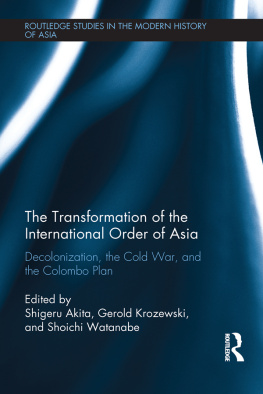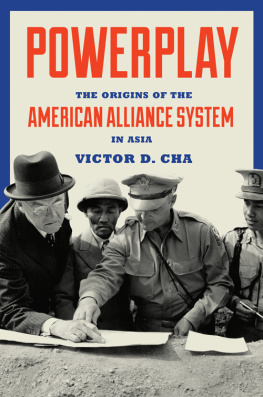THE RISE OF ASIA AND
THE TRANSFORMATION
OF THE WORLD-SYSTEM
edited by
Ganesh K. Trichur
Political Economy of the World-System Annuals, Volume XXX
Immanuel Wallerstein, Series Editor
First published 2009 by Paradigm Publishers
Published 2016 by Routledge
2 Park Square, Milton Park, Abingdon, Oxon OX14 4RN
711 Third Avenue, New York, NY 10017, USA
Routledge is an imprint of the Taylor & Francis Group, an informa business
Copyright 2009, Taylor & Francis.
All rights reserved. No part of this book may be reprinted or reproduced or utilised in any form or by any electronic, mechanical, or other means, now known or hereafter invented, including photocopying and recording, or in any information storage or retrieval system, without permission in writing from the publishers.
Notice:
Product or corporate names may be trademarks or registered trademarks, and are used only for identification and explanation without intent to infringe.
Library of Congress Cataloging-in-Publication Data
Trichur, Ganesh K.
The rise of Asia and the transformation of the world-system/Ganesh K. Trichur, editor.
p. cm. (Political economy of the world-system annuals ; v. 30)
Includes bibliographical references.
ISBN 978-1-59451-741-9 (hardcover : alk. paper)
1. AsiaEconomic conditions21st century. 2. AsiaSocial conditions21st century. 3. AsiaPolitics and government21st century. 4. GlobalizationAsia. I. Title.
HC412.T744 2009
337.5dc22
2009004020
Designed and Typeset by Straight Creek Bookmakers.
ISBN 13 : 978-1-59451-741-9 (hbk)
ISBN 13 : 978-1-59451-742-6 (pbk)
Ganesh K. Trichur
Introduction
The rise and upward mobility of the East Asian region in the hierarchy of the interstate system is the other side of the long-drawn-out world-systemic crisis of transition (Wallerstein 1982), a transition that began in the late 1960s with the crisis of U.S. hegemony (Arrighi 1994; Wallerstein 2000) over the interstate system. In the course of this crisis the terms globalization and neoliberalism began to occupy increasing attention from left and right, largely following the disintegration of the Soviet empire in the late 1980s alongside U.S. claims to be the only remaining superpower on the planet. As Goran Therborn and Habibul Haque (2006: 1) observe, our almost everyday use of the word globalization has nearly robbed itself of any great theoretical import or empirical value. Globalization is nevertheless the name for a U.S.-led project in the 1980s that succeeded the failed global development project (McMichael 2008) that the United States had spearheaded during the two Cold War decades following the 1945 Peace of Yalta. What Gilbert Rozman (2004: 353) calls the power of globalization and what others call the pursuit of open regionalism (Hamilton-Hart 2006: 114, 126) is closely related to the U.S. neoliberal project in the 1970s and 1980s to supply financial, political, and redistributive fixes for the late 1960searly 1970s crisis of ruling-class power emerging out of the more general crisis of overaccumulation of capital.
The overaccumulation crisis signaled the exhaustion of profitable opportunities and returns from further investments in the U.S.-led post-1945 free world developmental path organized through the Bretton Woods institutions (the World Bank and the International Monetary Fund [IMF]) and secured through far-flung U.S. military bases in Western Europe and East Asia. The fiscal and monetary crises in the United States that emerged out of U.S. military defeat in Southeast Asia created the conditions for the global stagflation (stagnant output and accelerating inflation) of the 1970s and the breakdown of the Bretton Woods institutions, alongside the serious erosion of the wealth and power of U.S. ruling classes. During most of the post-1945 period of strong world economic growth, the top 1 percent of income-earning U.S. households commanded a stable 8 percent share of national income. This share however, plunged precipitously in the 1970s (Harvey 2005: 44, 1522). Between 1965 and 1973 the rate of profit fell by 30 percent in the U.S. private business sector and by 20 percent in the G-7 core group of nations (Brenner 2002: 22). It was in this conjuncture that neoliberal globalizationin both the United States and in the UKdramatically consolidated itself in 1979 as a new orthodoxy regulating public policy in the capitalist core. In the 1980s the globalization project redefined development as successful participation in the world market (McMichael 2008: 117) and reconstituted class power in the core states by enabling ruling classes to switch from investments in material expansion to investments in an ongoing financial expansion (Arrighi 1994: 115).
Neoliberalism has meant in short, the financialization of everything (Harvey 2005: 31). In general it has meant the hypermobility of transnational capital since the mid-1980s. If in 1983 the combined foreign exchange reserves of the five largest central banks (in the United States, the UK, Germany, Switzerland, and Japan) dwarfed the average daily turnover of $39 billion circulating in major foreign exchange markets by more than 3:1, by 1986 they were about even in size; and by 1998 the volume of daily trading in foreign exchange markets ($1.8 trillion) was four times greater than the foreign exchange reserves of these five central banks (Pempel 1999b: 63). In particular, neoliberalism has meant the triumph of monetarist doctrines, extensive industrial and financial deregulation of national economies (although the United States, the European Union [EU], and Japan continue to protect agriculture through farm subsidies and tariffs), and widespread privatization of state-owned assets. If financial globalization has been the characteristic response of the world-system to historically recurring overaccumulation crises, the historical response to these system-wide crises has entailed the reconstitution of the world-system on entirely new structural foundations (Arrighi 1994: 7484). What these newer structural foundations are and whether or not these foundations will be built on more socialist and egalitarian structures than the foundations organized under previous world hegemonies is part of the ongoing struggles in the current transition. The rise of East Asia is, however, an integral part of the structural crisis.








